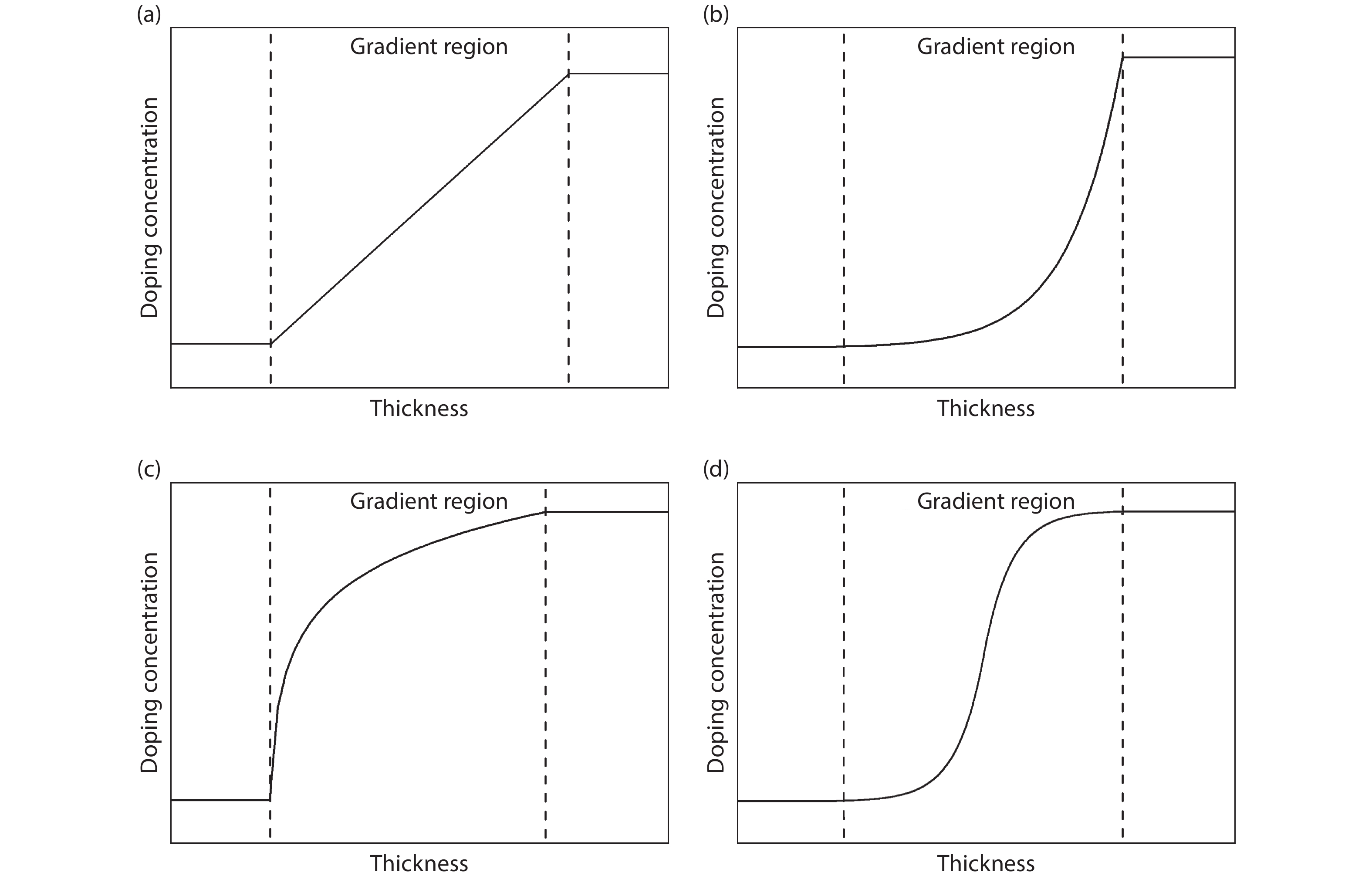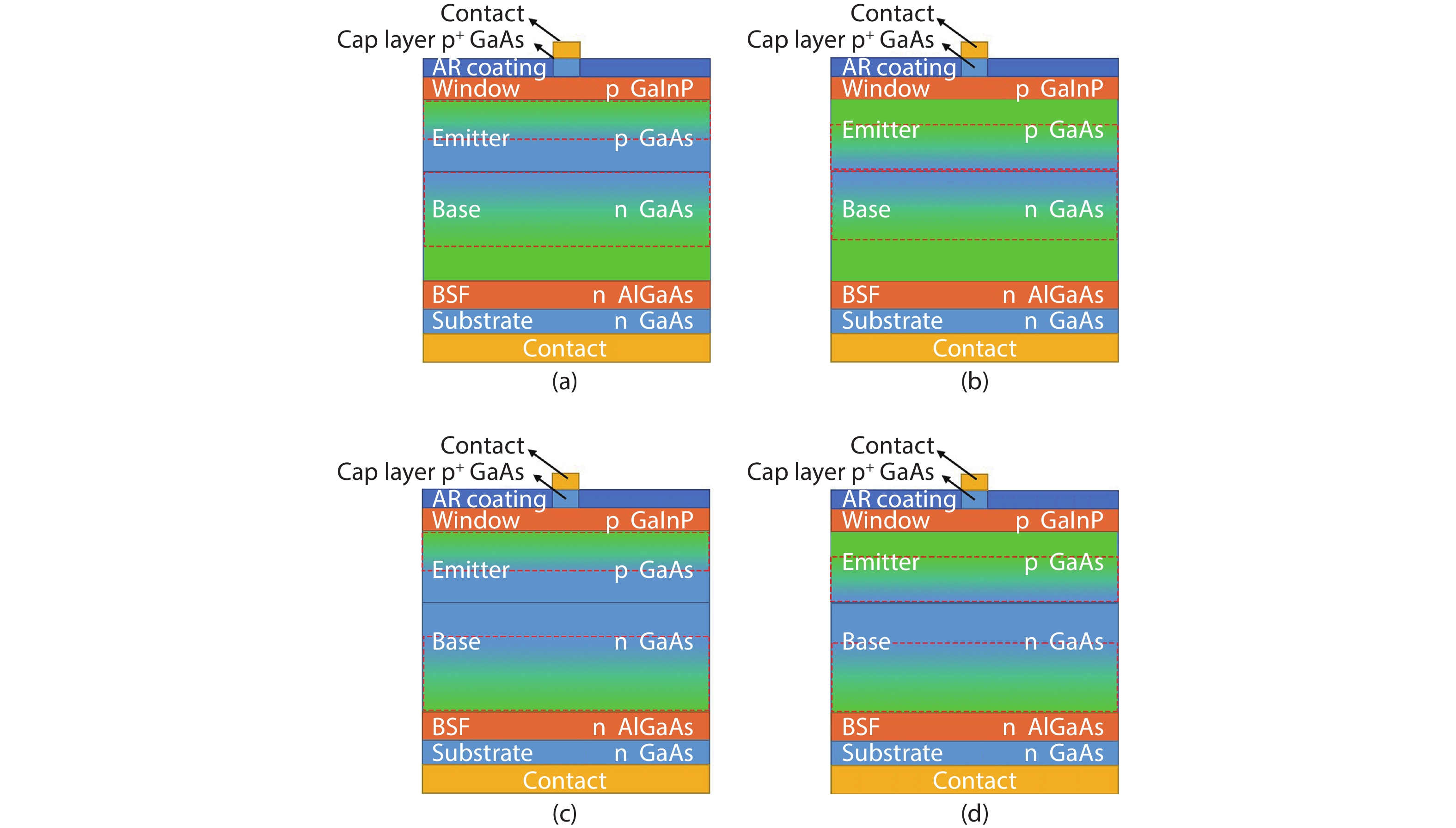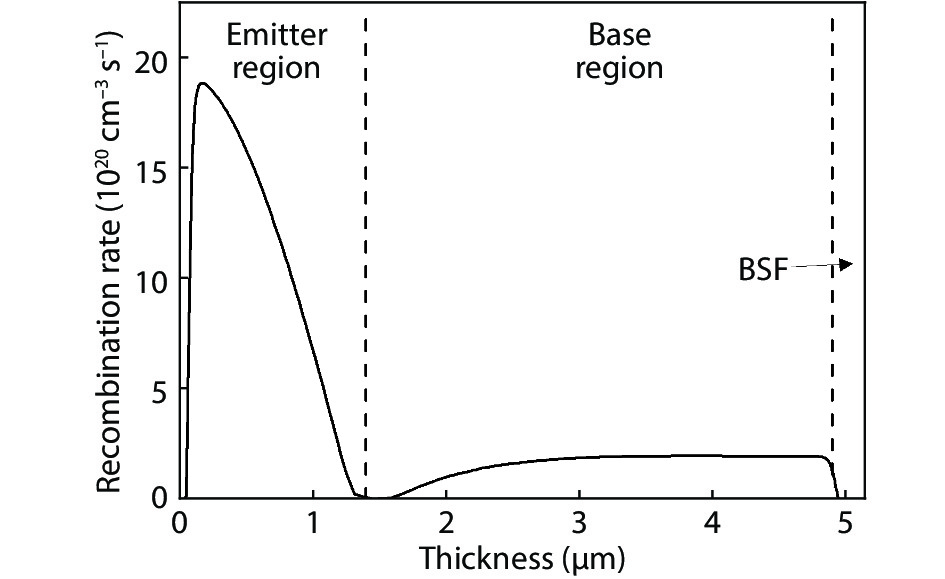| Citation: |
Yingjie Zhao, Shan Li, Huixue Ren, Shaojie Li, Peide Han. Energy band adjustment of 808 nm GaAs laser power converters via gradient doping[J]. Journal of Semiconductors, 2021, 42(3): 032701. doi: 10.1088/1674-4926/42/3/032701
****
Y J Zhao, S Li, H X Ren, S J Li, P D Han, Energy band adjustment of 808 nm GaAs laser power converters via gradient doping[J]. J. Semicond., 2021, 42(3): 032701. doi: 10.1088/1674-4926/42/3/032701.
|
Energy band adjustment of 808 nm GaAs laser power converters via gradient doping
DOI: 10.1088/1674-4926/42/3/032701
More Information
-
Abstract
The gradient doping regions were employed in the emitter layer and the base layer of GaAs based laser power converters (LPCs). Silvaco TCAD was used to numerically simulate the linear gradient doping and exponential gradient doping structure, and analyze the transport process of photogenerated carriers. Energy band adjustment via gradient doping improved the separation and transport efficiency of photogenerated carriers and reduced the total recombination rate of GaAs LPCs. Compared with traditional structure of LPCs, the photoelectric conversion efficiency of LPCs with linear and exponential gradient doping structure were improved from 52.7% to 57.2% and 57.7%, respectively, under 808 nm laser light at the power density of 1 W/cm2. -
References
[1] Guan C, Liu W, Gao Q. Influence of the mesa electrode position on monolithic on-chip series-interconnect GaAs laser power converter performance. Mater Sci Semicond Process, 2018, 75, 136 doi: 10.1016/j.mssp.2017.11.027[2] Andreev V, Khvostikov V, Kalinovsky V, et al. High current density GaAs and GaSb photovoltaic cells for laser power beaming. Proceedings of 3rd World Conference on Photovoltaic Energy Conversion, 2003, 761[3] Fave A, Kaminski A, Gavand M, et al. GaAs converter for high power laser diode. Conference Record of the Twenty Fifth IEEE Photovoltaic Specialists Conference, 1996, 101[4] Guan C, Li L, Ji H M, et al. Fabrication and characterization of a high-power assembly with a 20-junction monolithically stacked laser power converter. IEEE J Photovolt, 2018, 8(5), 1355 doi: 10.1109/JPHOTOV.2018.2841195[5] Shi J W, Kuo F M, Yang C S, et al. Dynamic analysis of cascaded laser power converters for simultaneous high-speed data detection and optical-to-electrical DC power generation. IEEE Trans Electron Devices, 2011, 58(7), 2049 doi: 10.1109/TED.2011.2136379[6] Ding Y, Li Q, Lu Y, et al. TO-packaged, multi-junction GaAs laser power converter with output electric power over 1 W. Conference on Lasers and Electro-Optics Pacific Rim, 2017[7] Kalyuzhnyy N A, Emelyanov V M, Mintairov S A, et al. InGaAs metamorphic laser (λ = 1064 nm) power converters with over 44% efficiency. InAIP Conference Proceedings, 2018, 2012, 110002[8] Green M A, Zhao J, Wang A, et al. 45-percent efficient silicon photovoltaic cell under monochromatic light. IEEE Electron Device Lett, 1992, 13(6), 317 doi: 10.1109/55.145070[9] Jarvis S D, Sweeney S J, Perren M, et al. Development and characterisation of laser power converters for optical power transfer applications. IET Optoelectron, 2014, 8(2), 64 doi: 10.1049/iet-opt.2013.0066[10] Khvostikov V P, Sorokina S V, Khvostikova O A, et al. GaSb laser-power (λ = 1550 nm) converters: Fabrication method and characteristics. Semiconductors, 2016, 50(10), 1338 doi: 10.1134/S1063782616100146[11] Fafard S, York M C A, Proulx F, et al. Ultrahigh efficiencies in vertical epitaxial heterostructure architectures. Appl Phys Lett, 2016, 108(7), 071101 doi: 10.1063/1.4941240[12] Krut D, Sudharsanan R, Nishikawa W, et al. Monolithic multi-cell GaAs laser power converter with very high current density. Conference Record of the Twenty-Ninth IEEE Photovoltaic Specialists Conference, 2002, 908[13] Schubert J, Oliva E, Dimroth F, et al. High-voltage GaAs photovoltaic laser power converters. IEEE Trans Electron Devices, 2009, 56(2), 170 doi: 10.1109/TED.2008.2010603[14] Algora C, Diaz V. Performance and optimization of monochromatic p/n heteroface AlGaAs/GaAs photovoltaic cells. Solid-State Electron, 1997, 41(11), 1787 doi: 10.1016/S0038-1101(97)00147-0[15] Shan T Q, Qi X L. Design and optimization of GaAs photovoltaic converter for laser power beaming. Infrared Phys Technol, 2015, 71, 144 doi: 10.1016/j.infrared.2015.03.010[16] Khvostikov V P, Sorokina S V, Potapovich N S, et al. Modification of photovoltaic laser-power (λ = 808 nm) converters grown by LPE. Semiconductors, 2018, 52(3), 366 doi: 10.1134/S1063782618030120[17] Hwang S T, Hwang T, Lee S, et al. Selective rear contact for Ga0.5In0.5P- and GaAs-based solar cells. Sol Energy Mater Sol Cells, 2018, 182, 348 doi: 10.1016/j.solmat.2018.03.037[18] Zhao Y, Liang P, Ren H, et al. Enhanced efficiency in 808 nm GaAs laser power converters via gradient doping. AIP Adv, 2019, 9(10), 105206 doi: 10.1063/1.5109133[19] Hwang S T, Kim S, Cheun H, et al. Bandgap grading and Al0.3Ga0.7As heterojunction emitter for highly efficient GaAs-based solar cells. Sol Energy Mater Sol Cells, 2016, 155, 264 doi: 10.1016/j.solmat.2016.06.009[20] Liu E, Zhu B, Luo J. The physics of semiconductors. 7th ed. Beijing: Pubulishing House of Electronics Industry, 2011 (in Chinese)[21] Xioang S Z, Zhu M F. Foundation and application of solar cell. Beijing: Science Press, 2009 (in Chinese) -
Proportional views






 DownLoad:
DownLoad:























